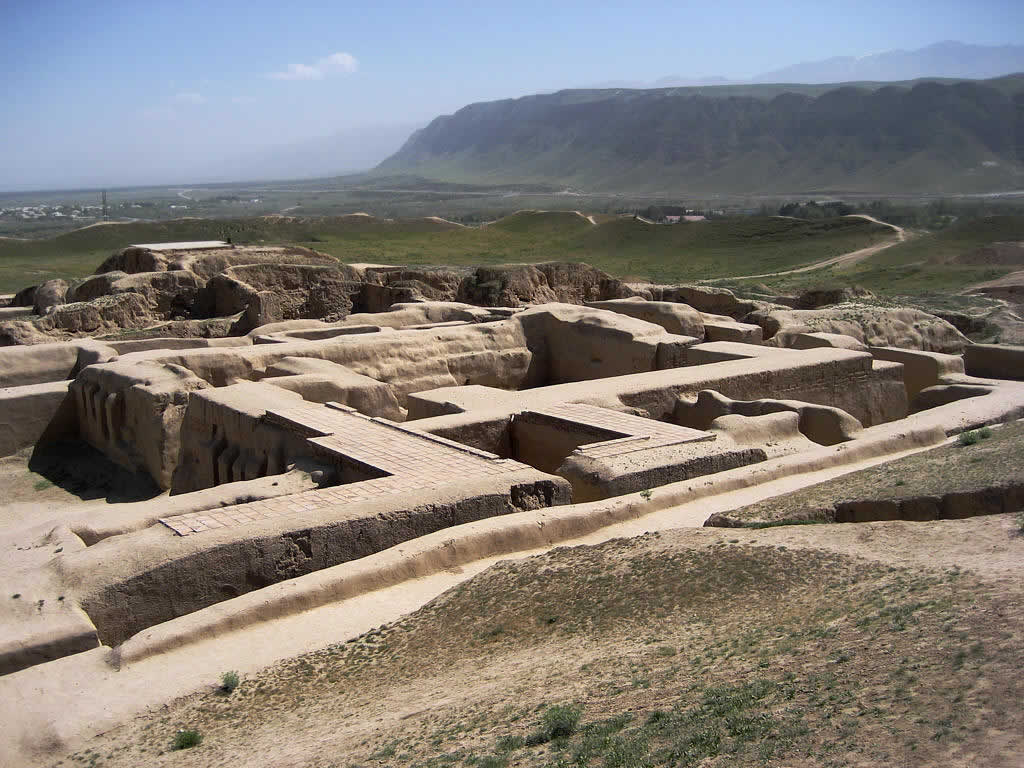UNESCO: The Parthian Fortresses of Nysa
by Kaveh Farrokh

April 4, 2020/in Archaeology, Architecture, Heritage, Military History 1900-Present, Parthian Military History, Parthians, UNESCO /by Kaveh Farrokh
The article “Parthian Fortresses of Nysa” was originally posted by UNESCO. The photographs inserted below are from the Meros.org venue, with the descriptive captions and map of the Parthian Empire provided by Kavehfarrokh.com. The version printed below has also been slightly edited.
====================================================
Nisa was the capital of the Parthian Empire, which dominated this region of central Asia from the mid 3rd century BCE to the early 3rd century CE. As such it formed a barrier to Roman expansion, whilst at the same time serving as an important communications and trading centre, at the crossroads of north-south and east-west routes. Its political and economic power is well illustrated by the surviving remains, which underline the interaction between central Asian and Mediterranean cultures.
 Map of the Parthian Empire in 44 BCE to 138 CE (Picture source: Farrokh, page 155, Shadows in the Desert: Ancient Persia at War-Персы: Армия великих царей-سایههای صحرا–). See also Military History and Armies of the Parthians …
Map of the Parthian Empire in 44 BCE to 138 CE (Picture source: Farrokh, page 155, Shadows in the Desert: Ancient Persia at War-Персы: Армия великих царей-سایههای صحرا–). See also Military History and Armies of the Parthians …
The Parthian Fortresses of Nisa consist of two tells of Old and New Nisa, indicating the site of one of the earliest and most important cities of the Parthian Empire, a major power from the mid 3rd century BC to the 3rd century AD. They conserve the unexcavated remains of an ancient civilization which skillfully combined its own traditional cultural elements with those of the Hellenistic and Roman west. Archaeological excavations in two parts of the site have revealed richly decorated architecture, illustrative of domestic, state and religious functions. Situated at the crossroads of important commercial and strategic axes, this powerful empire formed a barrier to Roman expansion while serving as an important communication and trading centre between east and west, north and south.
 A close-up of one of the sections of Nysa’s enduring Parthian system of architecture (Meros.org).
A close-up of one of the sections of Nysa’s enduring Parthian system of architecture (Meros.org).
UNESCO Criteria
Criterion (ii): Nisa is situated at the crossroads of important commercial and strategic axes. The archaeological remains vividly illustrate the significant interaction of cultural influences from central Asia and from the Mediterranean world.
Criterion (iii): The Parthian Empire was one of the most powerful and influential civilizations of the ancient world, and a brilliant rival of Rome which prevented the expansion of the Roman Empire to the east. Nisa, the capital of the Parthian Empire, is the outstanding symbol of the significance of this imperial power.
 A walled structure of one the chambers at Nysa(Meros.org). Later Sassanian architecture would also display especially thick walls and depending on the region, either bricks or stones could be used in their construction. For more on Parthian and Sassanian military architecture, consult Chapter 13 “Military Architecture” in Armies of Ancient Persia: The Sassanians (2017).
A walled structure of one the chambers at Nysa(Meros.org). Later Sassanian architecture would also display especially thick walls and depending on the region, either bricks or stones could be used in their construction. For more on Parthian and Sassanian military architecture, consult Chapter 13 “Military Architecture” in Armies of Ancient Persia: The Sassanians (2017).
The integrity and authenticity of the property, and also of the surrounding landscape, in terms of the size of the two tells and the siting of the capital at the foot of the Kopet-Dag mountains, are unquestionable. The two tells do not in any sense represent the original appearance of the Parthian capital, but their present appearance is due solely to natural erosion.
 A meandering pathway towards a Nysa structure(Meros.org).
A meandering pathway towards a Nysa structure(Meros.org).
The site is gazetted as one of the 1,300 historical and cultural monuments of Turkmenistan. Nisa is also one of the eight State Historical and Cultural Parks (SHCP) that have been created to protect the most significant sites in Turkmenistan. A buffer zone has been established. The property comes within the provisions of the Bagyr town development plan. Serious efforts are still needed to set up an efficient preventive maintenance scheme that will ensure the survival of recently excavated parts of the site. A five-year plan has been formulated for 2006-2010, in order to ensure a better balance between the different activities (e.g. archaeology vis-à-vis conservation) and to combine and harmonize all the existing documents and strategies relating to the site.
Related posts:
- UNESCO: Sassanian Archaeological Landscape of the Fars Region
- UNESCO: Takht-e Soleiman
- Journal Article: A Unique Parthian Sword
- Presentation on Parthian-era Warrior Women in Eleventh Annual ASMEA Conference Nov 1-3, 2018
- Parthian horses and Parthian Horse Archers
- Professor Shapour Shahbazi: The Parthian Army
- Parthian site in Andika, Khuzestan discovered by Karamian Archaeological Team
- Structure of the Parthian Army (2016) – (۱۳۹۵) ساختار ارتش اشکانیان
- Preserving the Buddhist Stupa Structure in Topdara, Afghanistan
- Documentary Film Production: the UNESCO Sassanian Fortress in Darband
http://kavehfarrokh.com/military-history-1900-present/unesco-the-parthian-fortresses-of-nysa/




















